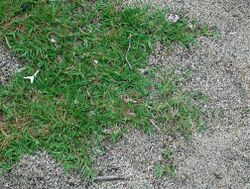Biology:Cynodon
| Bermuda grass | |
|---|---|

| |
| Cynodon dactylon | |
| Scientific classification | |
| Kingdom: | Plantae |
| Clade: | Tracheophytes |
| Clade: | Angiosperms |
| Clade: | Monocots |
| Clade: | Commelinids |
| Order: | Poales |
| Family: | Poaceae |
| Subfamily: | Chloridoideae |
| Tribe: | Cynodonteae |
| Subtribe: | Eleusininae |
| Genus: | Cynodon Rich. in Pers. 1805, not Brid. 1819 (a moss in family Ditrichaceae) |
| Type species | |
| Cynodon dactylon (L.) Pers.
| |
| Synonyms[1] | |
| |
Cynodon is a genus of plants in the grass family.[2] It is native to warm temperate to tropical regions of the Old World, as well as being cultivated and naturalized in the New World and on many oceanic islands.
The genus name comes from Greek words meaning "dog-tooth". The genus as a whole as well as its species are commonly known as Bermuda grass or dog's tooth grass.
- Cynodon aethiopicus - Africa; introduced in South Africa, Queensland, Hawaii, Texas
- Cynodon barberi - India, Sri Lanka
- Cynodon coursii - Madagascar
- Cynodon dactylon - Old World; introduced in New World and on various islands
- Cynodon incompletus - southern Africa; introduced in Australia, Argentina
- Cynodon × magennisii - Limpopo, Gauteng, Mpumalanga; introduced in Texas, Alabama
- Cynodon nlemfuensis - Africa from Ethiopia to Zimbabwe; introduced in South Africa, West Africa, Saudi Arabia, Philippines, Texas, Florida, Mesoamerica, northern South America, various islands
- Cynodon plectostachyus - Chad, East Africa; introduced in Madagascar, Bangladesh, Mexico, West Indies, Paraguay, northeastern Argentina, Texas, California
- Cynodon radiatus - China, Indian Subcontinent, Southeast Asia, Madagascar; introduced in Australia, New Guinea
- Cynodon transvaalensis - South Africa, Lesotho; introduced in other parts of Africa plus in scattered locales in Iran, Australia, and the Americas
- Formerly included[1]
Several species now considered better suited to other genera, namely Arundo, Bouteloua, Brachyachne, Chloris, Cortaderia, Ctenium, Digitaria, Diplachne, Eleusine, Enteropogon, Eragrostis, Eustachys, Gynerium, Leptochloa, Molinia, Muhlenbergia, Phragmites, Poa, Spartina, Tridens, and Trigonochloa.
Cultivation and uses
Some species, most commonly C. dactylon, are grown as lawn grasses in warm temperate regions, such as the Sunbelt area of the United States where they are valued for their drought tolerance compared to most other lawn grasses. Propagation is by rhizomes, stolons, or seeds. In some cases it is considered to be a weed; it spreads through lawns and flower beds, where it can be difficult to kill with herbicides without damaging other grasses or plants. It is difficult to pull out because the rhizomes and stolons break readily, and then re-grow.
It is also noted for its common use on the surface of greens on golf courses, as well as football and baseball playing fields.
Recent news reports claim that a Bermuda-derived F1 hybrid called Tifton 85 suddenly started producing cyanide and killed a cattle herd in Texas, USA.[5][6][7]
References
- ↑ 1.0 1.1 1.2 Kew World Checklist of Selected Plant Families
- ↑ Richard, Louis Claude Marie, in Persoon, Christiaan Hendrik. 1805. Synopsis Plantarum 1: 85
- ↑ The Plant List search for Cynodon
- ↑ Biota of North America Program 2013 county distribution maps
- ↑ CBS News (June 23, 2012). "Grass linked to Texas cattle deaths". CBS News. http://www.cbsnews.com/8301-201_162-57459357/gm-grass-linked-to-texas-cattle-deaths/.
- ↑ "TIFTON 85 BERMUDAGRASS". University of Georgia College of Agricultural and Environmental Sciences. http://www.tifton.uga.edu/fat/tifton85.htm.
- ↑ "Nitrates and Prussic Acid in Forages". Texas A&M University System. http://soiltesting.tamu.edu/publications/E-543.pdf.
External links
- Genus Cynodon on ITIS Report
- Cynodon on USDA/Natural Resource Conservation Service
- Lawn Maintenance Calendar (North Carolina)[|permanent dead link|dead link}}]
Wikidata ☰ Q959222 entry
 |

